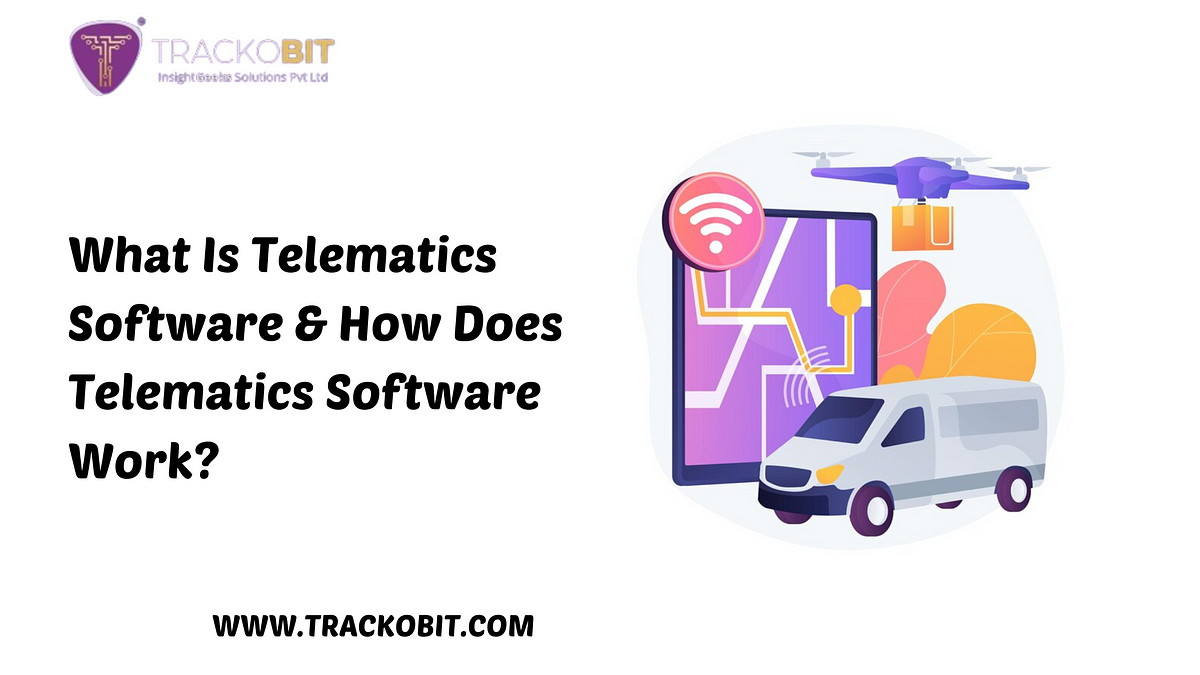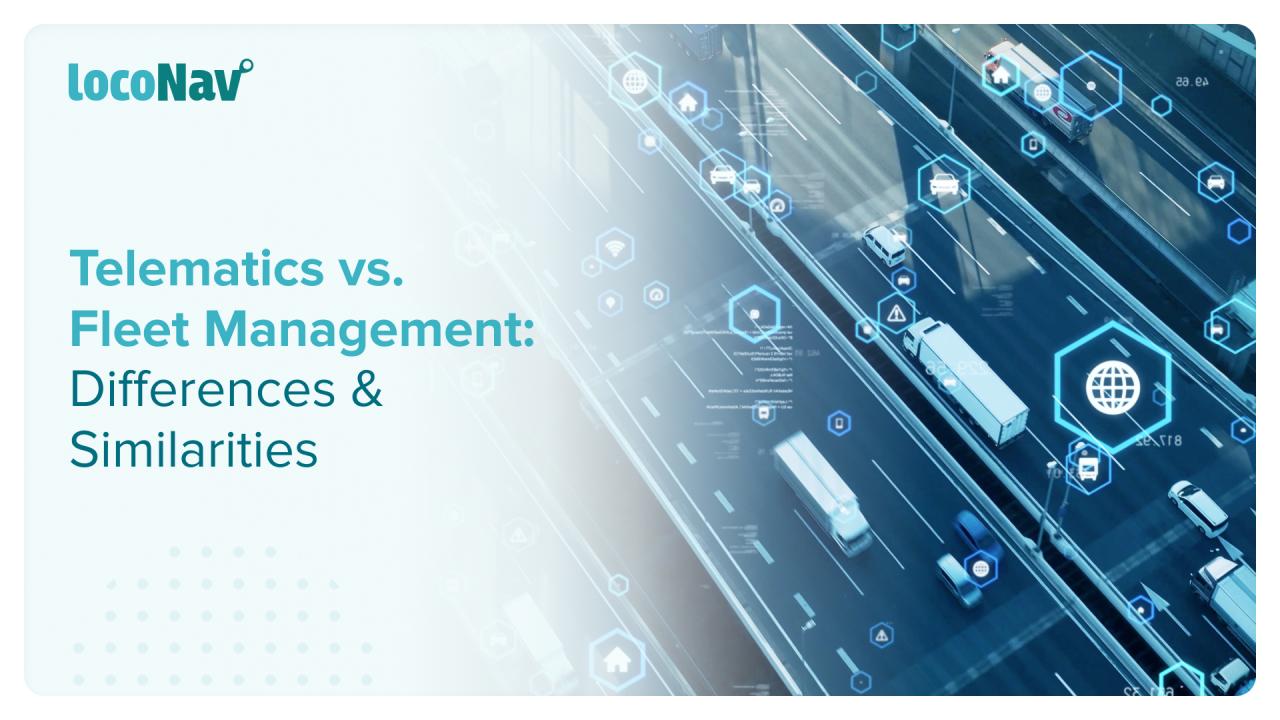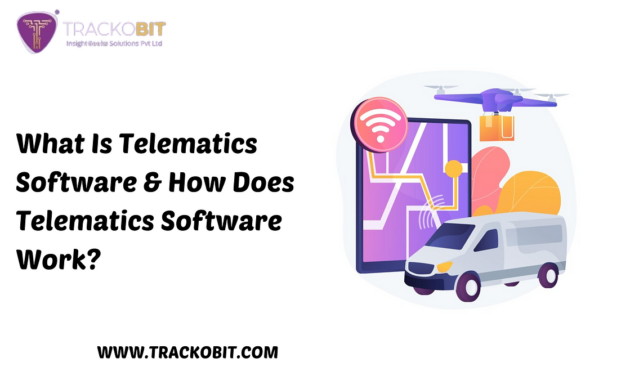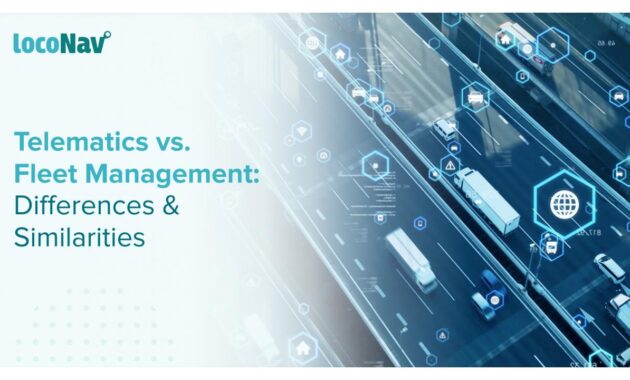Fleet vehicle telematics is reshaping how businesses manage their transportation resources, offering insights that drive efficiency and safety. As technology evolves, telematics systems have become integral to optimizing fleet operations, providing real-time data and analytics that enhance decision-making. From GPS tracking to onboard diagnostics, the components of telematics work in harmony to deliver unprecedented visibility into fleet performance.
This innovative approach not only streamlines operations but also contributes to significant cost savings, improved driver safety, and compliance with regulations. Understanding the intricacies of fleet vehicle telematics is essential for any organization looking to stay competitive in a fast-paced market.
Introduction to Fleet Vehicle Telematics
Fleet vehicle telematics refers to the integration of telecommunications and monitoring systems into vehicles, enabling real-time data transmission and analysis. This technology gathers information from various sensors installed in vehicles and transmits it to a centralized system for management and oversight. The significance of telematics in fleet management cannot be overstated; it enhances operational efficiency, improves safety, and reduces costs, making it an invaluable tool for fleet operators.The evolution of telematics technology has been remarkable over the years.
Originally, telematics focused on basic GPS tracking and route planning. Today, it encompasses advanced features like driver behavior analysis, vehicle diagnostics, and enhanced communication interfaces. The integration of artificial intelligence and machine learning into telematics systems has further transformed the landscape, allowing for predictive analytics and improved decision-making capabilities.
Significance of Telematics in Fleet Management
Telematics systems provide fleet managers with crucial insights that help optimize operations. The significance of these systems includes several key factors:
- Improved Safety: Telemetry data enables fleet managers to monitor driver behavior, identify risky practices, and implement corrective measures, which reduces accident rates.
- Cost Efficiency: By tracking fuel consumption, maintenance needs, and vehicle usage, telematics helps identify areas for cost savings and efficient resource allocation.
- Enhanced Route Planning: Real-time data allows for dynamic routing, helping drivers avoid traffic and delays, thus improving delivery times and overall service quality.
- Regulatory Compliance: Telematics assists companies in maintaining compliance with regulations related to vehicle operation, such as hours of service for drivers, which can help to avoid fines.
- Asset Utilization: By knowing the location and status of each vehicle, fleet managers can better utilize their assets, ensuring that vehicles are not idly sitting or overused.
The integration of telematics technology into fleet operations has led to substantial improvements across various metrics, demonstrating its critical role in modern fleet management.
Components of Fleet Vehicle Telematics
Fleet vehicle telematics systems comprise several essential components that work together to enhance operational efficiency, safety, and management capabilities. Understanding these components is crucial for fleet managers looking to optimize vehicle performance and improve logistics.The primary components of telematics systems include GPS technology, onboard diagnostic systems, and various sensors. Each of these elements plays a vital role in collecting, transmitting, and analyzing data to provide insights into vehicle performance, driver behavior, and overall fleet efficiency.
Essential Parts of Telematics Systems
The components of fleet vehicle telematics can be categorized into hardware and software elements, which work in unison to provide comprehensive insights. Below are the essential components:
- GPS Technology: Global Positioning System (GPS) is the backbone of telematics. It allows fleet managers to track vehicle locations in real-time, ensuring efficient route planning and monitoring of delivery times.
- Onboard Diagnostics (OBD): OBD systems monitor engine performance and provide data on vehicle health, including issues like engine malfunctions or maintenance needs. This information is crucial for preventing breakdowns and ensuring timely maintenance.
- Sensors: Various sensors collect data on vehicle speed, fuel consumption, tire pressure, and more. This data helps in understanding vehicle performance and addressing potential issues before they escalate.
- Telematics Devices: These devices combine GPS, OBD, and sensors into a single unit. They can be installed in vehicles to collect and transmit data to fleet management software for analysis.
Integration of GPS, OBD and Sensors
The integration of GPS, onboard diagnostics, and sensors is fundamental to the effectiveness of fleet telematics. By collaborating, these components create a comprehensive data ecosystem that enables real-time monitoring and long-term planning.
“The synergy of GPS, OBD, and sensors transforms raw data into actionable insights, enhancing fleet management capabilities.”
The GPS provides location data, which can be cross-referenced with OBD data to analyze driving behaviors such as speeding or idling. Sensors further enhance this by offering insights into vehicle conditions, alerting managers to potential risks or maintenance requirements. This holistic view allows fleet managers to make informed decisions that can lead to significant cost savings and improved vehicle longevity.
Types of Telematics Devices
Various telematics devices are available on the market, each offering unique features tailored to different fleet needs. These devices can be categorized based on functionality and application. Here are some common types:
- Plug-and-Play Devices: These are easy-to-install OBD devices that connect directly to the vehicle’s diagnostic port. They are often used for basic tracking and diagnostics.
- Hardwired Devices: More permanent installations that directly connect to the vehicle’s electrical system. These devices are ideal for fleets requiring comprehensive monitoring, as they can provide more detailed data.
- Mobile Apps: Many telematics providers offer mobile applications that allow for real-time monitoring and management from any location. These apps can interface with existing telematics systems for streamlined management.
- Advanced Fleet Management Systems: These systems integrate multiple data streams, including GPS tracking, vehicle diagnostics, and sensor data, into a single platform for robust analytics and reporting.
Benefits of Implementing Telematics in Fleet Management

The integration of telematics into fleet management systems has become a game changer for businesses operating vehicle fleets. Various features of telematics technology not only streamline operations but also significantly reduce costs and enhance safety. In this section, we will explore how telematics enhances operational efficiency, leads to cost savings in fuel management and maintenance, and improves driver safety and compliance.
Enhancements in Operational Efficiency
Telematics systems provide real-time data that allows fleet managers to monitor vehicle performance and driver behaviors closely. This data collection enables timely decision-making and optimizes various aspects of fleet operations. Key areas of operational efficiency improvements include:
- Route Optimization: By analyzing traffic patterns and vehicle locations, telematics can suggest the most efficient routes, reducing travel time and fuel consumption.
- Real-time Tracking: Fleet managers can track vehicles in real-time, leading to better dispatching and enhanced customer service by providing accurate ETAs.
- Maintenance Alerts: Telematics systems can send alerts for scheduled maintenance needs, helping to avoid costly repairs and vehicle downtimes.
Cost Savings in Fuel Management and Maintenance
Fuel and maintenance costs can represent a significant portion of a fleet’s operating budget. Telematics offers tools that help reduce these expenses through effective management strategies. Below are some ways telematics contributes to cost savings:
- Fuel Consumption Monitoring: Telemetry data allows for detailed analysis of fuel usage, helping identify inefficient driving behaviors, such as excessive idling or hard braking.
- Preventative Maintenance: By maintaining vehicles based on actual usage data rather than arbitrary schedules, companies can reduce unexpected repairs and extend vehicle lifespan.
- Driver Training Programs: Insights from telematics can inform targeted training sessions for drivers, leading to more economical driving habits that contribute to reduced fuel costs.
Improvements in Driver Safety and Compliance
Driver safety is paramount in fleet management, and telematics plays a crucial role in promoting safe driving practices. This technology not only ensures the well-being of drivers but also aids in regulatory compliance. The enhancement of safety and compliance is observed in the following ways:
- Driver Behavior Monitoring: Telematics systems can track driving habits such as speeding, harsh braking, and cornering. This data facilitates coaching and reinforcement of safe driving practices.
- Accident Reporting: In the event of an accident, telematics provides immediate data, which streamlines incident reporting and supports insurance claims processes.
- Regulatory Compliance: Fleet managers can utilize telematics data to ensure adherence to Department of Transportation (DOT) regulations, including Hours of Service (HOS) compliance, thus avoiding penalties.
Data Utilization in Fleet Vehicle Telematics
In the realm of fleet management, the effective use of telematics data can significantly enhance operational efficiency, reduce costs, and improve service quality. By leveraging the vast amounts of data generated by telematics systems, fleet managers can gain valuable insights into various aspects of their operations including vehicle performance, driver behavior, and route optimization.The collection and analysis of telematics data involve several methods that transform raw data into actionable insights.
These methods are essential for understanding fleet dynamics and making informed decisions. Key techniques include:
Methods for Collecting and Analyzing Telematics Data
The collection of telematics data can be conducted through a variety of means that include:
- GPS Tracking: Utilizing global positioning systems to monitor vehicle locations, enabling real-time tracking and route optimization.
- Onboard Diagnostics (OBD): Gathering engine and vehicle performance data which helps in assessing maintenance needs and fuel efficiency.
- Driver Behavior Monitoring: Analyzing driving patterns such as harsh braking, acceleration, and speed to improve driving habits and reduce accidents.
- Geofencing: Setting up virtual perimeters for vehicles to monitor when they enter or exit designated areas, enhancing security and operational control.
The analysis of this data can be performed using advanced software platforms that apply algorithms and analytics techniques to generate reports and forecasts.
Role of Data Visualizations in Decision-Making Processes
Data visualization plays a crucial role in transforming complex data sets into understandable formats. In fleet management, visualizations can simplify the interpretation of telematics data, allowing for quicker and more informed decision-making. Effective visualizations can include:
- Dashboards: Real-time data dashboards display key performance indicators (KPIs) such as fuel usage, vehicle health, and driver efficiency in a clear, concise manner.
- Heat Maps: Geographic visualizations that highlight high and low traffic areas, helping managers optimize routes and reduce congestion.
- Trend Charts: Graphical representations of data trends over time, enabling fleet managers to identify patterns and forecast future performance.
“Data visualization enhances comprehension, leading to quicker and more effective strategic decisions.”
Importance of Real-Time Data Monitoring
Real-time data monitoring is fundamental in fleet vehicle telematics, providing instant access to critical information that can influence operational decisions. Immediate insights into vehicle status, driver actions, and environmental conditions allow fleet managers to respond swiftly to emerging situations. Key benefits of real-time monitoring include:
- Immediate Alerts: Automated notifications for maintenance needs or incidents, ensuring prompt action to mitigate risks.
- Enhanced Safety: Monitoring driver behavior in real time can lead to safer driving practices and reduced accident rates.
- Operational Efficiency: Adjusting routes and schedules based on real-time traffic data can improve delivery times and reduce fuel consumption.
“Real-time monitoring transforms reactive management into proactive strategies, significantly enhancing overall fleet performance.”
Challenges and Limitations of Fleet Vehicle Telematics

Implementing fleet vehicle telematics comes with a range of challenges and limitations that fleet managers must navigate to fully realize the benefits of such systems. Understanding these obstacles is crucial for making informed decisions about technology adoption and integration into existing workflows. Recognizing the potential pitfalls can help mitigate risks and enhance the overall effectiveness of telematics.
Common Challenges in Implementation
Fleet managers often encounter several challenges when implementing telematics systems. These challenges can hinder the adoption process and impact the return on investment (ROI).
- Cost of Implementation: The initial investment for telematics technology, including hardware and software, can be significant. Budget constraints may limit the ability to implement comprehensive solutions.
- Resistance to Change: Employees may be resistant to new technologies, fearing job security or adjusting to new workflows. Overcoming this resistance requires effective change management strategies.
- Training and Adoption: Proper training is essential for staff to effectively use telematics systems. Insufficient training can lead to underutilization of the technology and diminished benefits.
- Data Overload: The vast amount of data generated by telematics can overwhelm fleet managers. Without proper systems in place to analyze and interpret this data, valuable insights may be missed.
Data Privacy and Security Limitations
Data privacy and security are pressing concerns in the realm of fleet vehicle telematics. Protecting sensitive information while exploiting the advantages of data collection is critical for fleet managers.
- Vulnerability to Cyber Attacks: Telematics systems are susceptible to hacking and unauthorized access, posing risks to both vehicle operations and sensitive data.
- Compliance with Regulations: Fleet managers must navigate various data protection regulations, such as GDPR or CCPA, which dictate how personal data is collected, stored, and used.
- User Privacy Concerns: Employees may be apprehensive about being monitored, leading to potential conflicts regarding trust and transparency within the organization.
Integration Issues with Existing Systems
Integrating telematics solutions with existing fleet management systems can present several challenges that may impact operational efficiency.
- Compatibility of Systems: Diverse software and hardware solutions may not seamlessly integrate, leading to data silos and fragmented information management.
- Legacy Systems Constraints: Older systems may lack the capabilities to interface with new telematics technologies, resulting in additional costs for upgrades or replacements.
- Data Synchronization: Ensuring that data from telematics is consistent and accurately synced with other operational systems can be complex, requiring careful planning and execution.
Future Trends in Fleet Vehicle Telematics
The landscape of fleet vehicle telematics is rapidly evolving, driven by advancements in technology and increasing environmental awareness. As industries seek to optimize operations and enhance sustainability, understanding future trends is essential for fleet managers looking to stay ahead. Emerging technologies like AI and IoT are reshaping the telematics ecosystem, providing innovative solutions that promise to revolutionize fleet management.
Emerging Technologies Impacting Telematics
The integration of Artificial Intelligence (AI) and the Internet of Things (IoT) is transforming fleet vehicle telematics. AI algorithms are being applied to analyze massive datasets collected from vehicles, enabling predictive maintenance, route optimization, and improved driver behavior monitoring. IoT devices enhance connectivity, allowing real-time data exchange between vehicles and fleet management systems. This synergy not only boosts efficiency but also enhances safety and reduces operational costs.For example, AI-powered telematics can predict vehicle failures before they occur by analyzing historical performance data and current driving conditions.
This proactive approach minimizes downtime and repair costs. Similarly, IoT sensors can monitor tire pressure, fuel consumption, and engine diagnostics, providing fleet managers with actionable insights to improve fleet performance.
Advancements in Vehicle Connectivity, Fleet vehicle telematics
The future of fleet vehicle telematics hinges on the anticipated advancements in vehicle connectivity. With the rollout of 5G technology, vehicles will experience unparalleled connectivity, enabling faster data transmission and real-time communication. This will allow for more sophisticated applications, such as remote vehicle control, advanced driver-assistance systems (ADAS), and enhanced navigation services.The deployment of Vehicle-to-Everything (V2X) communication is also on the horizon.
This technology will allow vehicles to communicate with each other and with infrastructure elements, such as traffic lights and road signs. By sharing information about road conditions and traffic patterns, V2X communication can significantly enhance safety and efficiency, paving the way for autonomous vehicle integration into fleets.
Response to Environmental Concerns
As environmental concerns become increasingly pressing, telematics will evolve to promote sustainability within fleet management. Fleet operators are now prioritizing eco-friendly practices by utilizing telematics data to enhance fuel efficiency and reduce emissions. By analyzing driving patterns and vehicle performance, fleets can adopt strategies that minimize their carbon footprint.For instance, telematics systems can identify routes that optimize fuel consumption, leading to lower greenhouse gas emissions.
Moreover, advancements in electric vehicle (EV) telematics are improving the management of electric fleets, ensuring that charging and maintenance are optimized for performance and sustainability. As the industry shifts toward greener alternatives, telematics will play a pivotal role in monitoring and managing the environmental impact of fleet operations.
Case Studies of Successful Telematics Implementation
In the rapidly evolving landscape of fleet management, telematics has emerged as a game-changer. This section highlights notable organizations that have successfully implemented telematics solutions, examining their strategies, the outcomes they achieved, and the lessons learned from their experiences. These case studies provide valuable insights into the practical benefits of telematics in real-world applications.
UPS: Optimizing Delivery Routes
United Parcel Service (UPS) is a prime example of a company that has leveraged telematics to enhance its operations. By implementing advanced telematics systems, UPS optimized its delivery routes, which significantly reduced fuel consumption and improved delivery efficiency.The strategies adopted included:
- Data-Driven Route Planning: Using real-time data from telematics, UPS analyzed traffic patterns and weather conditions, allowing them to adjust routes dynamically.
- Driver Behavior Monitoring: Telematics systems monitored driver performance, enabling UPS to provide targeted training that improved safety and reduced accidents.
- Fuel Efficiency Initiatives: The company implemented technologies that minimized idling time and optimized fuel usage, directly lowering operational costs.
The outcomes of UPS’s telematics implementation were remarkable:
- Fuel savings of approximately 10 million gallons annually.
- Reduction in carbon emissions, contributing to UPS’s sustainability goals.
- Enhancement in on-time delivery rates, leading to increased customer satisfaction.
Key takeaway: Leveraging data insights not only cuts costs but also enhances service quality.
Verizon Connect: Improving Fleet Visibility
Verizon Connect successfully transformed its fleet operations by utilizing telematics to enhance visibility and operational efficiency for its customers.Their approach included:
- Comprehensive Fleet Tracking: Implementation of GPS tracking that provided real-time location data of all vehicles in the fleet.
- Maintenance Alerts: Using telematics to schedule proactive maintenance based on vehicle usage and diagnostic data, reducing breakdowns.
- Driver Performance Programs: Analyzing driving behaviors to create programs that reward safe driving and reduce liability risks.
The results were significant:
- Increased fleet utilization rates by 15%.
- Reduction in accident rates due to improved driver training and awareness.
- Enhanced customer service through better delivery tracking and communication.
Lesson learned: Visibility into fleet operations can lead to smarter decisions and better resource allocation.
FedEx: Enhancing Operational Efficiency
FedEx is another leader in logistics that has harnessed the power of telematics to streamline its operations and improve efficiency.Their implementation strategies comprised:
- Real-Time Data Analytics: Utilizing telematics to gather and analyze data on vehicle performance and operational metrics.
- Integration with Existing Systems: Combining telematics data with existing transportation management systems for a holistic view of operations.
- Training and Development: Creating training programs based on telematics feedback to improve driver skills and safety practices.
The outcomes of FedEx’s telematics initiative included:
- Fuel cost reductions by approximately 5% due to optimized routing.
- Improved delivery times, directly enhancing customer satisfaction levels.
- Reduction in maintenance costs as a result of timely vehicle servicing.
Key insights: Integrating telematics with existing management systems amplifies the benefits of data analysis.
Lessons Learned from Successful Implementations
The case studies of UPS, Verizon Connect, and FedEx reflect several common themes in successful telematics implementations. These include the importance of:
- Adopting a data-centric approach to decision-making.
- Ensuring robust training programs for staff to maximize efficiency.
- Prioritizing integration with existing systems to enhance operational capabilities.
- Focusing on sustainability and cost reduction as dual goals.
Ultimately, the experiences of these organizations illustrate how telematics can revolutionize fleet management, yielding both operational efficiencies and improved customer satisfaction.
Best Practices for Fleet Vehicle Telematics Implementation

Successful implementation of fleet vehicle telematics doesn’t just involve the technology itself; it requires a thoughtful approach that integrates the needs of the organization, the staff, and the vehicles. Adopting best practices ensures that the benefits of telematics are maximized while minimizing potential challenges during the transition.Effective telematics integration begins with a clear checklist that Artikels essential steps all stakeholders should follow.
This checklist serves as a roadmap to ensure that no critical aspect of the implementation process is overlooked.
Checklist for Successful Telematics Integration
A comprehensive checklist can streamline the telematics implementation process. Here are key elements that should be included:
- Define clear goals and objectives for telematics use.
- Choose a reliable telematics provider with a strong track record.
- Assess current fleet operations to identify areas for improvement.
- Ensure compatibility with existing systems and infrastructure.
- Set a realistic budget that encompasses installation and ongoing costs.
- Develop a data management plan for effective analysis and reporting.
- Engage stakeholders across departments for support and input.
- Establish metrics for success and methods for performance evaluation.
Training staff is a crucial component of the transition to a telematics system. Proper education on the new technology fosters acceptance and helps maximize its potential.
Training Methods for Staff Adaptation
Training staff effectively enhances their ability to utilize telematics features, leading to improved fleet performance. Consider the following methods to facilitate such training:
- Conduct hands-on workshops that allow employees to interact with the telematics system directly.
- Utilize online tutorials and resources that staff can access at their convenience.
- Provide ongoing support through a designated team or expert who can answer questions and solve problems.
- Encourage team-based learning, where experienced users share insights with newer users.
- Regularly update training materials to reflect system updates and introduce new features.
To ensure the telematics system remains effective over time, organizations must commit to ongoing evaluation and improvement. This proactive approach can significantly enhance fleet management processes.
Tips for Ongoing Evaluation and Improvement
Continuous evaluation of telematics systems is vital for identifying areas of improvement and maximizing investment. Here are some strategies to ensure ongoing success:
- Regularly review collected data to identify trends and areas requiring attention.
- Gather feedback from staff on the system’s usability and functionality.
- Schedule routine maintenance checks and system upgrades to optimize performance.
- Monitor industry trends to stay informed about new technologies and practices that could enhance telematics use.
- Set up a review process to assess the effectiveness of implemented strategies and make necessary adjustments.
“Successful telematics integration is not just about technology; it’s about people, processes, and a clear vision.”
User Queries: Fleet Vehicle Telematics
What is fleet vehicle telematics?
Fleet vehicle telematics refers to the integration of telecommunications and monitoring systems to track and manage fleet vehicles in real-time.
How can telematics improve driver safety?
Telematics can enhance driver safety by providing data on driving behaviors, enabling training and interventions to reduce risky practices.
Are there privacy concerns related to telematics?
Yes, privacy concerns arise regarding data collection and monitoring, necessitating stringent security measures to protect sensitive information.
What types of telematics devices are available?
Several types of devices are available, including GPS trackers, onboard diagnostic tools, and advanced telematics units that integrate multiple functionalities.
How does telematics contribute to fuel management?
Telematics improves fuel management by providing insights into fuel consumption patterns, enabling more efficient routing and reducing waste.
What future trends can we expect in telematics?
Future trends include the integration of AI and IoT technologies, leading to more sophisticated analytics and enhanced vehicle connectivity.















